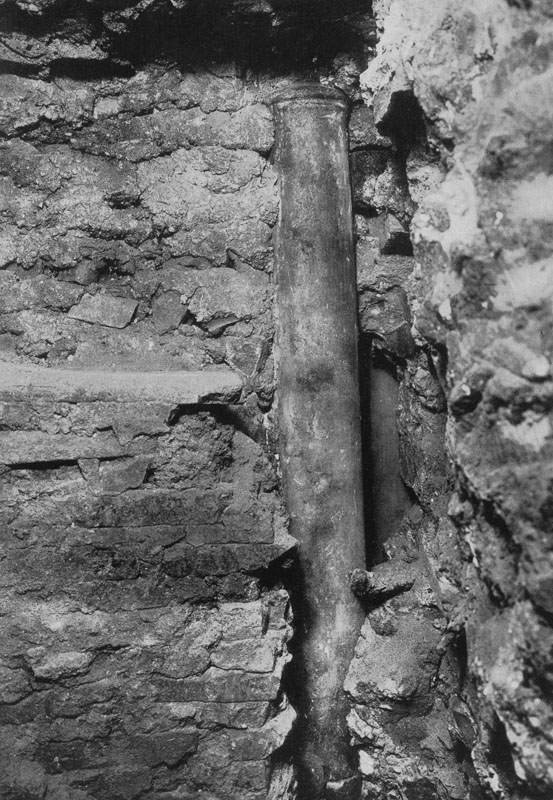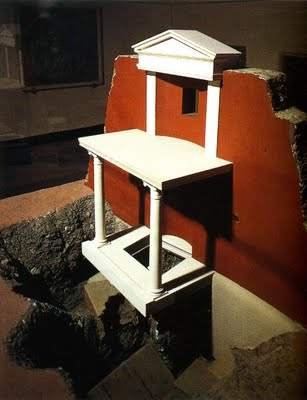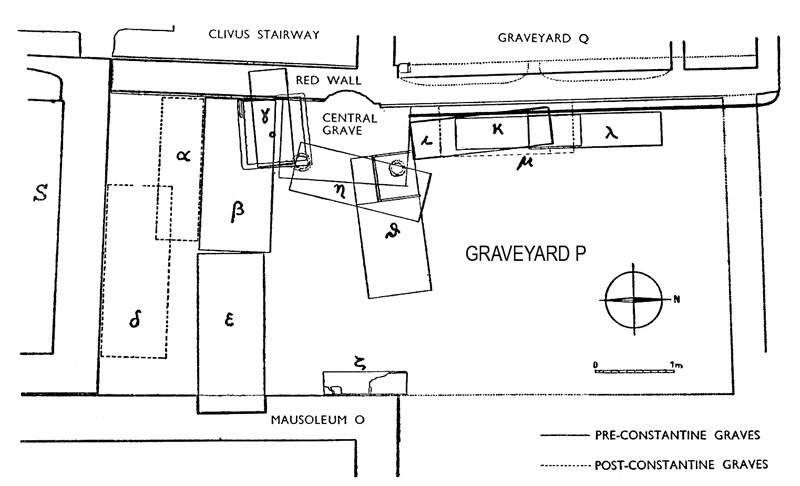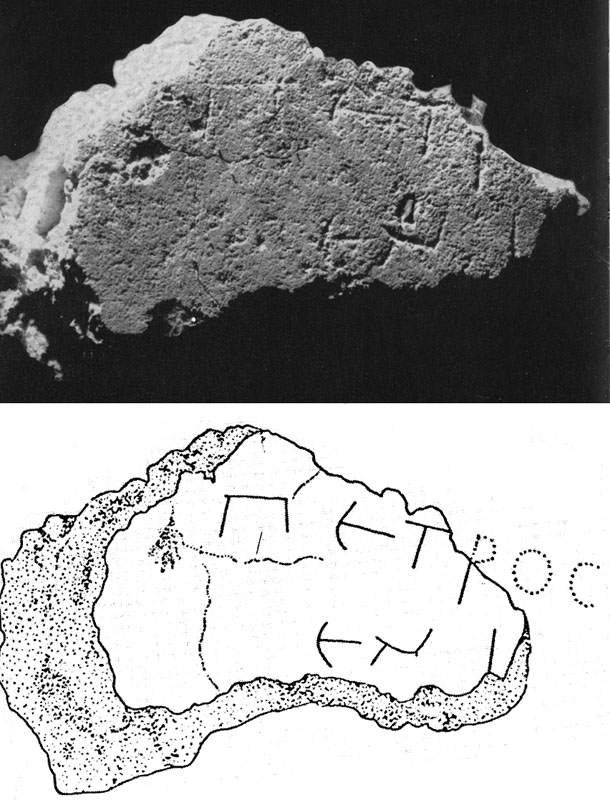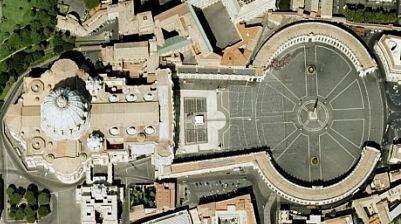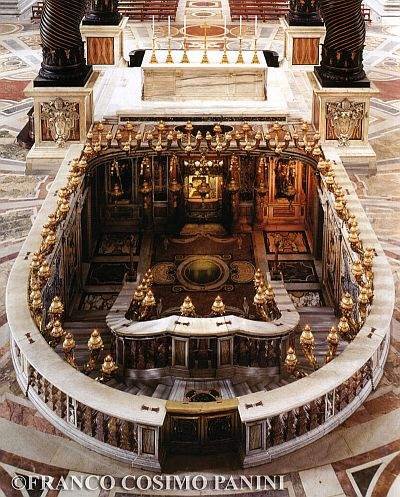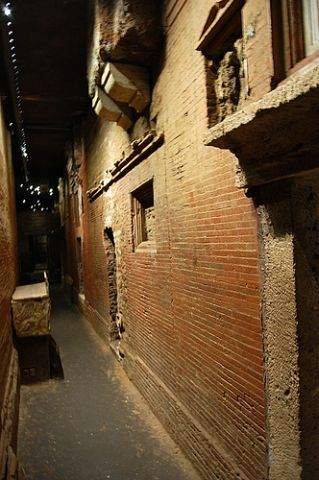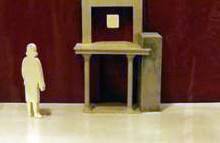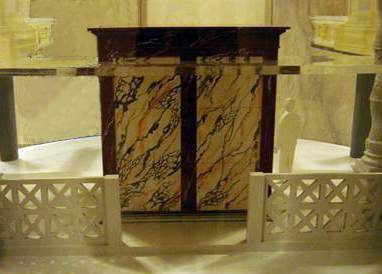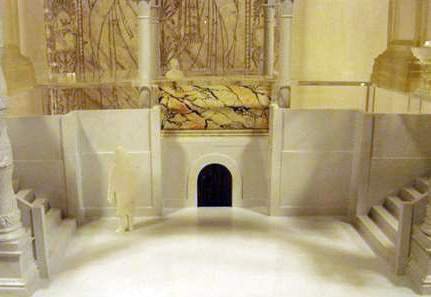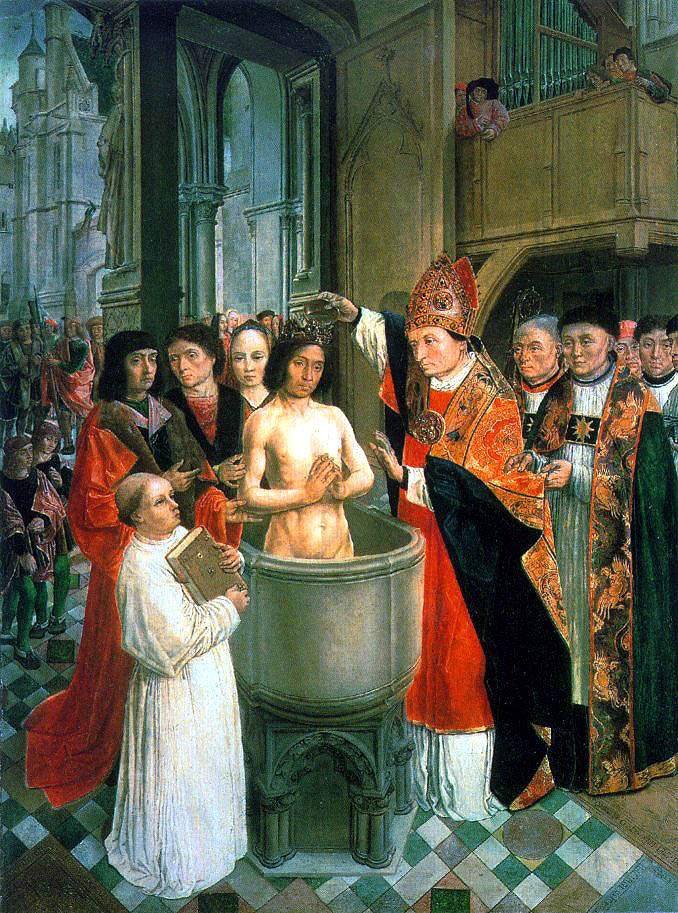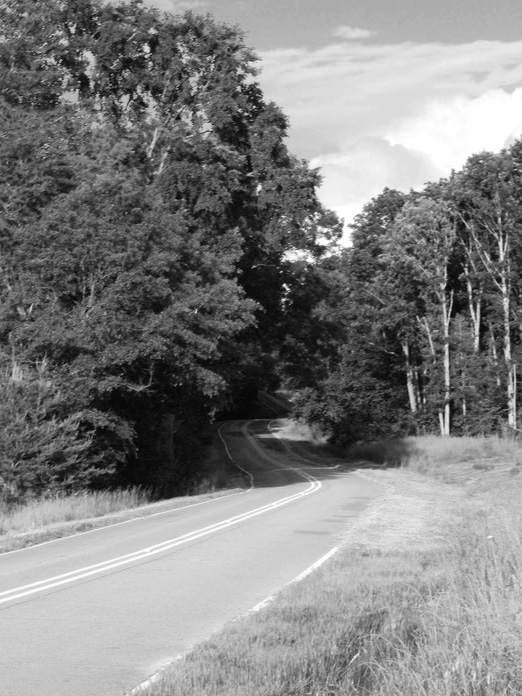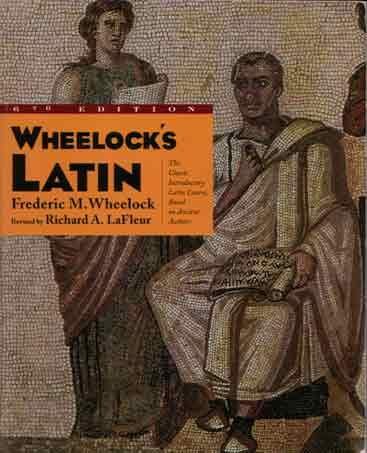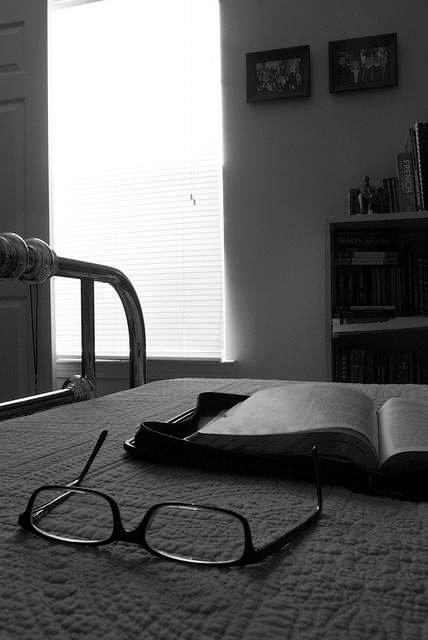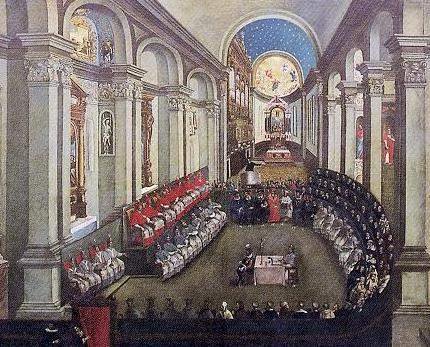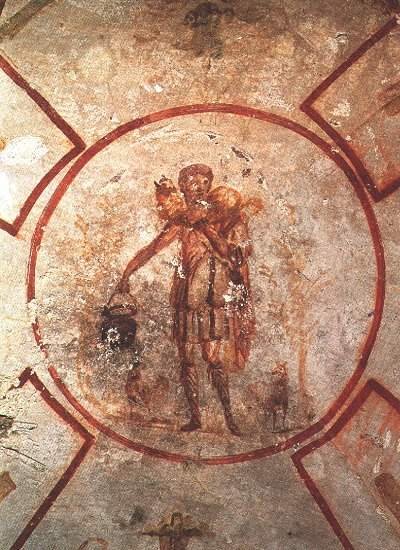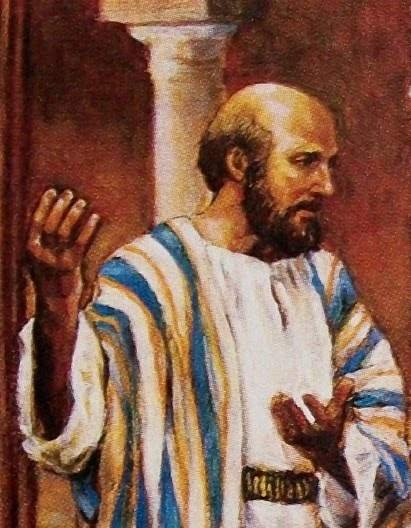Last time, I gave a brief history of the tomb of St. Peter on the Vatican, and of the excavations in the 1940s that uncovered the ancient pagan necropolis beneath St. Peter’s Basilica. I left the matter of the excavation of the tomb itself for this post — which is bound to be a little more technical.
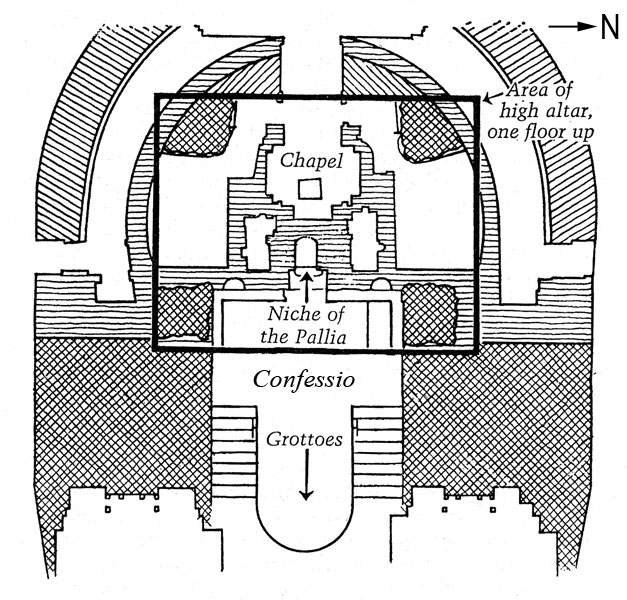
A simplified plan of the lower level of the basilica, in relation high altar above (marked by the rectangle), the Clementine Chapel, the Confessio, and the Grottoes. (Walsh)
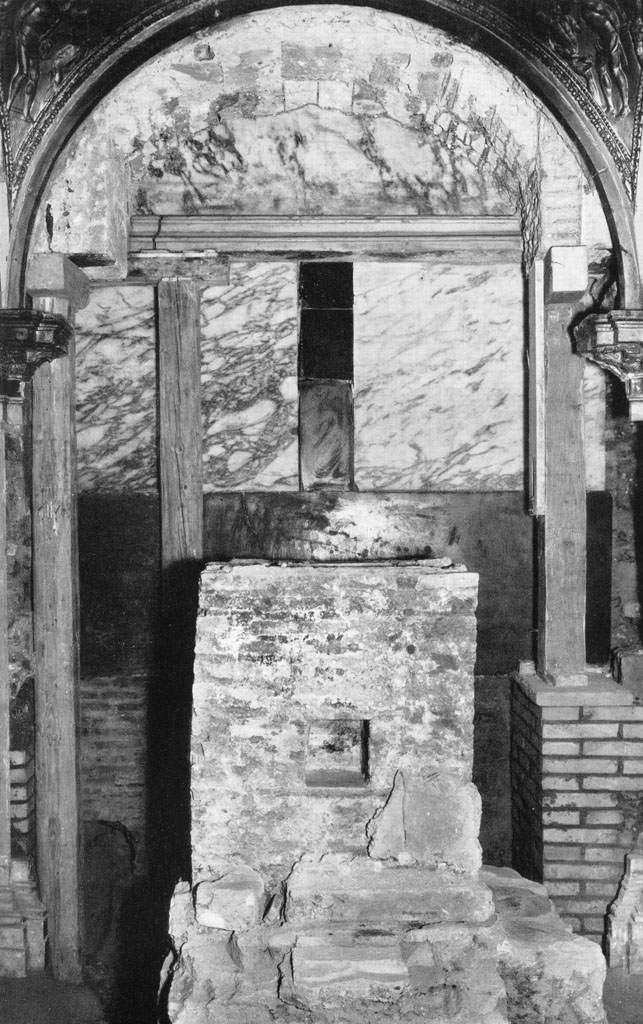
The rear of the Clementine Chapel, after the brick wall and altar decorations had been removed. The marble visible is the rear of Constantine’s memoria. (Fabbrica di San Pietro)
When the excavation team at last made the decision to investigate what lay beneath the high altar of St. Peter’s Basilica, the immediate question was how to get at it. The archaeologists had been instructed by the pope not to disrupt the daily functioning of St. Peter’s as a church in any way — so they could not exactly dig into the altar itself, nor approach from the Niche of the Pallia in the confessio, which was visible from above and a site of pilgrimage.
The Clementine Chapel lay on the west side of the altar. Behind the chapel’s rear (east) wall should have been the area immediately under the altar. Removing the brick wall, the archaeologists discovered a wall of ancient, white marble, with a narrow strip of porphyry in the center — the rear side of Constantine’s memoria, they later realized. At the top could be seen the twelfth century high altar of Pope Callixtus II, upon which is built the present altar.
Prying loose the strip of porphyry, the excavators first saw the ancient Red Wall. Breaking a small hole in the wall, they spotted the shell of another, older altar above, nestled in Callixtus’s: the altar of Gregory the Great. Unwilling to damage the wall further, they decided to search for a way to approach the altar shrine from the north or south.
Behind the side walls of the chapel, the archaeologists discovered two narrow passageways leading to closet-sized spaces on either side of the shrine (the open spaces within the circular crypt in the diagram above).
Entering the southern space, they attempted to break through the wall of the shrine from this south. Here the team caught their first glimpse of Peter’s Tropaion: a thick slab of travertine extending from the Red Wall, its edge resting on a small marble column; it all being packed in tightly with mortar and brick.
Approaching next from the north side in the same way, they discovered a much thicker wall, covered with a facing of plaster. This wall was scratched with layers upon layers of graffiti, intertwining and crossing each other and jumbled together. Visible were many examples of the labarum, the chi-rho monogram of Christ, which Constantine had adopted as his standard following a vision of Christ at the Battle of the Milvian Bridge in 312.

The Graffiti Wall, on the north side of the Tropaion, showing the repository. (Fabbrica di San Pietro)
Near the bottom of the Graffiti Wall, a narrow strip of plaster had fallen, revealing a marble-lined receptacle within the wall. At that time, the archaeologists were unwilling to damage the valuable graffiti by enlarging the hole, so they left the cavity alone, deciding instead to continue investigation on the Red Wall, the edges of which were now visible through the holes they had made to the north and the south of the shrine.

The Niche of the Pallia, as it resides within the elements of the tomb’s masonry. (Fabbrica di San Pietro)
Having approached the shrine from the west, south, and north, the group opted to examine it from the Niche of the Pallia on the east side. This they did at night after the basilica had closed its doors. Though unable to probe deeply without damaging the niche’s ancient mosaic, the view confirmed their findings so far. They noted that the travertine slab resting on the column, now broken, had once been a solid piece. Englebert Kirschbaum, S.J., one of the archaeologists, described their night sessions as “unforgettable not so much because of surprising discoveries . . . but on account of the enchantment radiating from the basilica at night time” (Kirschbaum 77).
Finally, the archaeologists made the decision to explore beneath the Tropaion, by digging under the Graffiti Wall on the north side. Before they did, they investigated the marble receptacle, widening the hole in the plaster and examining inside: it was empty, save for a few bone fragments, a medieval coin, and other debris.
Digging under the graffiti wall, the archaeologists first encountered a simple slab grave dating to the fourth century — one of many graves in the area, apparently of those desiring to be buried close to the martyr. Deeper, at the foundation of the wall, they struck a grave dating to the late first century. Here they decided to breach the foundation of the wall itself to see what lay behind.
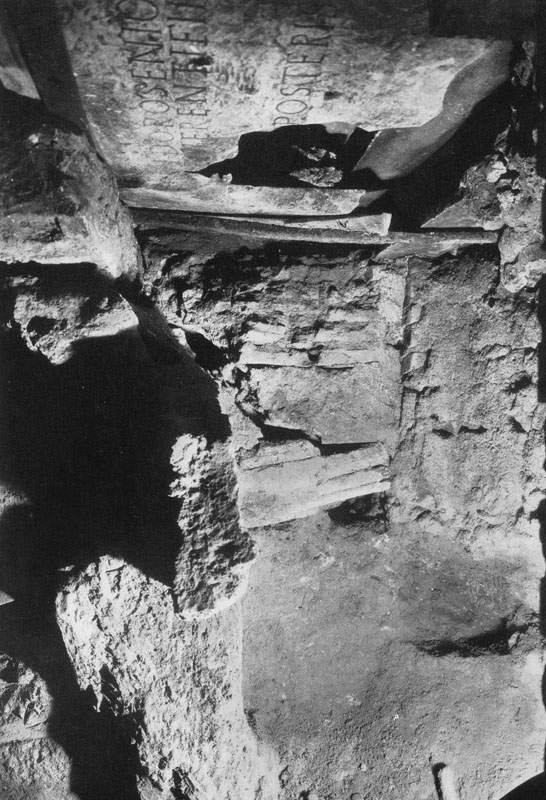
The interior of the grave beneath the Tropaion, from north side looking south. On the south wall are the remains of the two retaining walls. The closure slab can be seen overhead. (Fabbrica di San Pietro)
Removing the bricks of the foundation opened upon a hollow space. Kirschbaum, the smallest of the excavators, crawled through the opening. Overhead, the ceiling was a marble slab apparently removed from one of the nearby pagan tombs to cover the space, slanted at an angle slightly askew from the rest of the monument. The dirt floor was littered with ancient coins, dating as far back as Imperial Rome. (An opening had been left in the tomb cover, and a shaft down from the high altar, through which pilgrims could drop offerings or pour libations.) The north wall of the chamber showed the remains of two low walls, in line with the slab above, that had been built to retain the sides of the space as the ground of the cemetery was built up around it. To the east was the wall of another grave, placed so close as to nearly breach into it. Hanging from above in one corner was the lower part of a small marble column, the twin to the one seen standing from the south, supporting the now-broken travertine slab — perhaps evidences of the sack of the basilica by Saracens in 846. To the west was the Red Wall, with a curious, rough cavity in its foundation. Kirschbaum was in the space immediately below the Tropaion. This was the central grave: this was the grave of St. Peter.
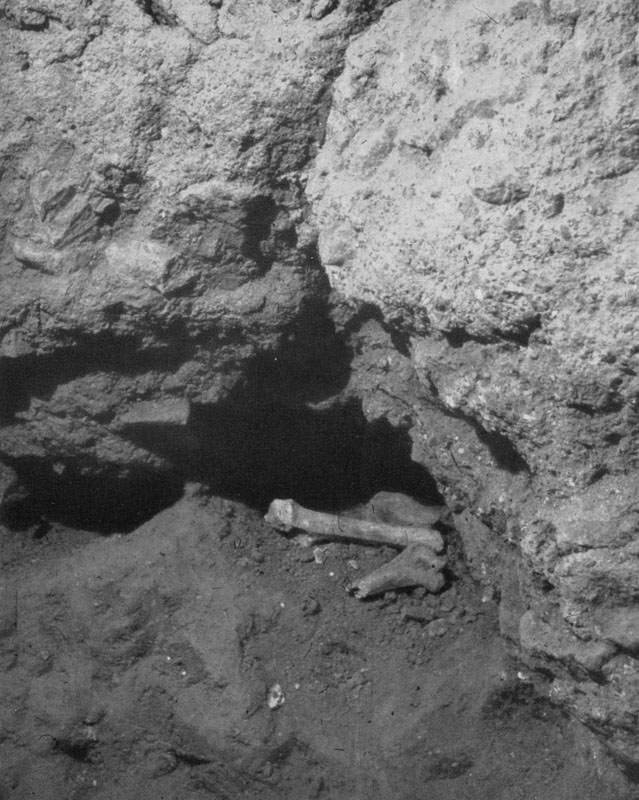
The bones found beneath the Red Wall (briefly replaced there for the photograph). (Fabbrica di San Pietro)
Feeling within the niche in the foundations of the Red Wall, Kirschbaum discovered bones: not in the grave itself, but in one side of it. These he carefully handed out to his colleagues. Solemnly, the team would later present their find to Pope Pius. Despite their academic bearing, it was difficult for the archaeologists not to presume these might be the bones of St. Peter.
This was 1942. A cursory examination by the pope’s physician declared the bones to be those of a man in his seventies, strongly built. The bones would reside for years in lead boxes in the pope’s private chambers. They would not be carefully examined by a forensic expert until 1956. During the intervening years, in 1949, the press would seize upon the rumor that the bones of St. Peter had been discovered. A year later, Pope Pius announced publicly that the tomb of St. Peter had been definitively discovered, and that bones had been found, their identity unconfirmed.
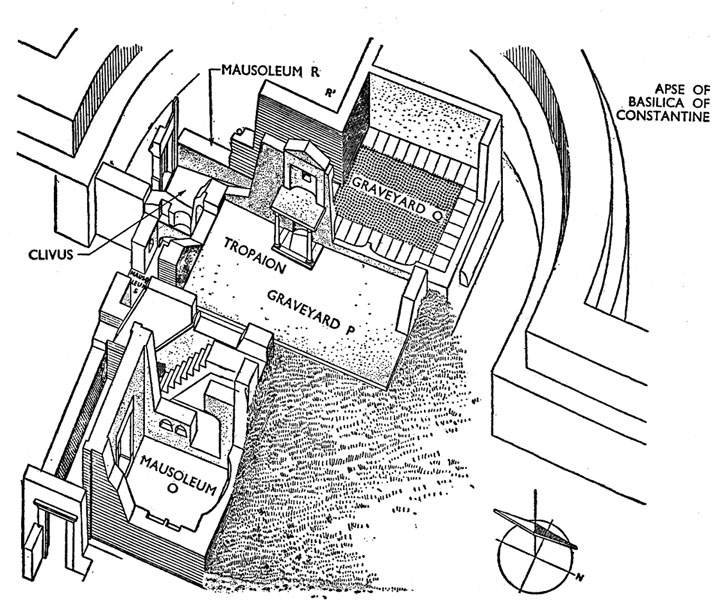
The reconstructed layout of the necropolis graveyards in relation to the apse of Constantine’s basilica. (Fabbrica di San Pietro)
The archaeologists would continue their excavation for another seven years, until 1950. They carefully examined and reconstructed the Tropaion and its central grave, as well as the many graves in the surrounding area, and their connection to the necropolis beneath. The courtyard that contained the Red Wall and Tropaion, called Graveyard P, was elevated from the other parts of the necropolis on account of the slope of the hill. Behind the Red Wall, an alleyway, called the Clivus, sloped down from another area of graves and passed two other tomb chambers.
Graveyard P had a long history of burials, graves layered upon each other, with the ground of the area built up on a number of occasions. But the central grave, which the excavators dated to the second half of the first century, was always carefully maintained and preserved. A number of graves appeared to have been placed with the intention of being as close as possible to the central grave — perhaps these were successive popes? Eventually, in the mid-second century, the Red Wall and Clivus were built, and the Tropaion, extending from the Red Wall, was erected over the central grave.
Kirschbaum, writing in 1957, called this grave “the grave with the richest tradition in Western Christianity.” In recounting the tomb’s “historical evolution,” he noted that the very notion ran counter to the idea of a grave (Kirschbaum 120-121):
“Normally, graves have no history, not even the history of their development. If graves have any history, it is the story of their decay. They are not living beings capable of growth from small beginnings to stature and strength. Graves are true symbols of death. Like the bodies they conceal, they can only crumble. Their zenith is at the start, what comes after is disintegration. This is true not only of the modest graves of ordinary mortals which barely last for two or three generations, it is true also of the world’s proudest funerary monuments, the royal pyramids of Egypt or the gigantic mausoleums of Imperial Rome. True, they have endured thousands of years but in gradual decay. All that remains is a dreadful shadow of their one-time magnificence.
“Few graves on earth have transcended this interior rhythm of death and disintegration. And these are not the tombs of the mighty ones of the earth but those of the saints, who even after their deaths live on in the world with a mysterious effectiveness. Among them, this apostolic grave with its remarkable and mysterious power and influence that develops throughout the centuries.”
Certainly, the veneration shown to this grave, from the very day of its inception, marked it as the resting place of someone of particular importance to the community who buried its occupant — a martyr or a saint. The Christian community in Rome would not have so venerated a grave, from such an early date, if they had not known for certain that it was the grave of their Apostle and Bishop — if they had not obtained the body following Peter’s crucifixion and buried it themselves. Neither would they have lost, forgotten, or neglected it, and clearly they did not. The Church in Rome held this to be the grave of St. Peter from the time of his death; they cared for and no doubt visited the site, and yet maintained its secrecy from Roman officials throughout the centuries of persecution. When they built the Tripaion between 150 and 167, they fashioned it in the form of a pagan funerary monument, the aedicula, which commonly featured a niche or alcove for urn burials. This aedicula, however, stood over an inhumation grave, at a time when only Christians inhumed their dead.
Is there any other physical evidence marking this tomb as Peter’s? The archaeologists discovered one item in particular, a fragment of the Red Wall that had broken off, on which they found a Greek inscription, hastily scratched in the plaster. It appears to read ΠΕΤΡΟΣ ΕΝΙ: Peter is within.
In May 1952, Pope Pius invited Dr. Margherita Guarducci, a professor of Greek epigraphy at the University of Rome, to visit the Scavi and attempt to decipher some of the more arcane and illegible inscriptions. In particular there was a graffito on the wall of one of the pagan tombs, possibly scrawled by one of Constantine’s workmen, that referenced Peter. The early excavators had been unable to read it completely. Dr. Guarducci soon reconstructed the words: PETRUS ROGA CHRISTUS JESU PRO SANCTIS HOMINIBUS CRESTIANUS AD CORPUS TUUM SEPULTIS (Peter pray Christ Jesus for the holy Christian men buried near your body).
Regarding the Graffiti Wall, the excavators had initially been disappointed not to find the name of Peter inscribed anywhere on it. Even the name of Christ was marked only in labara. Dr. Guarducci was troubled by the tangled, overlapping, seemingly random markings that covered much of the wall. Finally, after months of poring over the inscriptions, she saw it: a cryptographic code, with every overlapping of letters relevant to the relationships between names and ideas, and monograms used to represent the names of God, Christ, and Mary. And at last, the name of Peter, in the form of monograms connecting Greek rho (Ρ), which resembles a Roman P, and E. (The form I’ve copied to the left can also double as a representation of a key, one of Peter’s attributes.)
With the combined weight of all of these factors — the dating of the grave to the late first century and the monument to the mid-second century; the evidence of continued veneration of the grave since its placement; the later graves crowded around the central grave; the early inscriptions indicating the presence of Peter’s body; both the tradition and the documentary testimony placing Peter’s gravesite on the Vatican; the construction of the Tropaion over the grave and eventually St. Peter’s Basilica itself — I consider it a virtual certainty that this is in fact the grave of the Apostle Peter.
Well, I didn’t get done this time, either. I guess there is a lot to share! Next time, the discovery of the relics of St. Peter, and a discussion of their authenticity. Stay tuned for the exciting conclusion, “The Bones of St. Peter.”
All photographs and diagrams are © Fabbrica di San Pietro, and appear in Engelbert Kirschbaum, S.J., The Tombs of St. Peter and St. Paul (New York: St. Martin’s Press, 1959). Another source for much of this material is John Evangelist Walsh, The Bones of St. Peter (New York: Doubleday, 1982).

